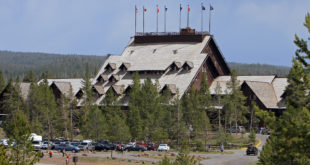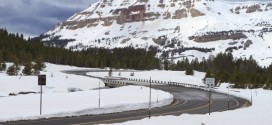By Sean Reichard
When someone mentions Idaho, what is the first thing that comes to mind? If you’re like me, it’s potatoes. Mountains and mountains of potatoes, piled so high they block out the sun. Is that what you think when you hear the word Idaho? Well, stop it. There are more things in Idaho than potatoes. Idaho Falls is one of those places.
Idaho Falls’s history starts long before the famous Lewis and Clark expedition blazed a trail for other people seeking opportunity and wealth in the West, Idaho was mostly inhabited by Native Americans. When Lewis and Clark, along with the rest of their group, were passing through again after reaching the Pacific Coast, one of the members left the expedition and went southwest. His name was John Colter, and he discovered the Teton Pass and wintered in the Teton Valley. Lewis and Clark described the “richness of the territory” when they returned to Washington, D.C., which prompted trappers and traders to journey to Idaho.
Thirty miles south of Idaho Falls was one of the first settlements, Fort Hall, which was set up as a trading post in 1834. Besides that, most people only passed through Idaho on the Oregon Trail. It wasn’t until 1860 that settlers started coming in droves, hoping to hit the jackpot mining gold. Along with settlers, the gold rush brought about the need for towns to cater to the miners and other settlers coming to Idaho. In 1864, a man named Harry Rickets started a ferry service across the Snake River, and J. Matt Taylor built a bridge that same year because of how turbulent the river was. The community of Idaho Falls wasn’t always called Idaho Falls. It used to be called Eagle Rock, named after a rock where 20 eagles made their nests (eagles don’t nest there anymore, I’m afraid). But the town people wanted to change it, and on August 26th, 1891, they voted to name it Idaho Falls.
Things started to look bad once all the gold was mined, but those who did (including some early Mormon pioneers), found success in creating an irrigation and agriculture.
It’s a nice, easy drive to Idaho Falls from Yellowstone, especially if you want to take a day trip that doesn’t require as much driving as Bozeman or Billings. The best place to start would be Old Faithful, where you take the Grand Loop Road to US-191, go left, and follow US-191 to the West Entrance. Turn right at Boundary St., then left at Firehole Av., and then take US-20 for 106 miles. Take the Lindsay Blvd. exit to get onto Lindsay Blvd, and follow it until you reach W. Broadway St.
Idaho Falls has something for everyone to do. It doesn’t matter if it’s just yourself, or you and your family of eleven. There are plenty of exciting things to do and see when you’re in Idaho Falls. For starters, if you’re looking to enjoy the outdoors, then head over to the Visitor Center (505 Lindsay Blvd.) for an event calendar, maps, hiking and camping information, and hunting/fishing regulations, among other things.
For outdoor sports, try playing golf at one of the three public courses that are nearby the city. These courses would include the 18-hole Sandcreek Golf Course (5200 S. 25th E.), the 18-hole Pinecrest Golf Course (701 E. Elva St.), and the 18-hole Sage Lakes Municipal Golf Course (100 E. 65th N).
If you’re looking for outdoors excitement, then try your hand at whitewater rafting. Guides are available to take you to the South Fork of the Snake River, but other places to raft include south of Jackson on the Snake River, and on the Salmon River in Central Idaho. Check for more information at the Visitor Center on Lindsay Boulevard.
For people looking to enjoy the outdoors, yet want to avoid getting wet, try camping. There are several camping places around the area such as campsites in the Palisades Reservoir region. To get to Palisades Reservoir, go southeast on W. Broadway St. towards Park Av., then left at N. Yellowstone Hwy, and keep going on US-26 for 59.4 miles to the reservoir.
Another camping area would be Island Park, which coincidentally, you pass when coming out of the West Entrance of Yellowstone National Park. Just head back up US-20 E. to reach Island Park.
Don’t have the time, ability, or desire to camp? No problem. Take the walk around the Greenbelt, a 2 1/3 mile walk around Snake River. Along the walk, you can go north to John Hole’s Bridge, which goes into Freeman Park, and you can see the Vietnam Veterans Memorial. Go south to see a replica of the original bridge built by J. Matt Taylor. Another sight along the Greenbelt is the historic downtown area, where you can grab food and shop.
Another outdoor sight to see would be the Idaho Falls themselves.
A great place for the whole family is the Tautphaus Park Zoo (between 17th St. and Sunnyside) which includes 5 baseball/softball fields, 1 soccer field, a football field, carnival rides during the summer, a ice skating rink, and the Idaho Falls Zoo, along with five playgrounds.
If you’re not an outdoor person, then you’d want to check out the Museum of Idaho (Corner of Broadway and Yellowstone Hwy) and the Bonneville Museum (Elm St. and Eastern Av.). The Museum of Idaho includes permanent exhibits about the community that came before Idaho Falls, Eagle Rock, and information about Idaho’s involvement in the development of nuclear/atomic energy, and space for traveling exhibits depending on the time of year. It costs $6 for an adult ticket, but only $5 if you’re in a group of 15 or more adults. Senior (62+) tickets cost $5 as well. Senior groups only have to pay $4 if they’re in a group of 15 or more, which is the same cost for a child ages 4-18. Student groups only cost $2 per person with a minimum of 15 students, with 1 chaperone per 10 students. Any extra chaperone has to pay for a full ticket. Children under age 4 are free.
The other museum, the Bonneville Museum, is currently the largest museum in Idaho, and contains permanent exhibits that house information about Idaho’s natural history, early inhabitants, agriculture, mining, military, and nuclear energy all on the first floor. Other features include a Reading and Reference Room, and a gift shop to help supplement the museum. The cost to go is $6 for adults $5 for seniors 62+, $4 for children 4-18, and free for children younger than four. A family can pay $19 to enter.
So after a long day of museum exploring, golfing, walking, or shopping, it’s time to head home or go to bed. Whether you’re heading back to Yellowstone National Park, to your campsite, or to a hotel room, rest assured that you’ve had a pleasant day in Idaho Falls, Idaho.
 Yellowstone Insider Your Complete Guide to America's First National Park
Yellowstone Insider Your Complete Guide to America's First National Park





